The subtleties of planting irises in the spring in open ground

With the onset of warm spring days, a painstaking and laborious time begins for gardeners and summer residents. At the end of spring, all the plants in the garden or on the plot are mostly just gaining color. However, among them there are flowers that delight with early bright colors and aromas. One of these plants is irises.
They bloom from late May to mid-July. These are unpretentious and non-capricious plants. They have a large palette of shades - from black to white.
Suitable varieties
Each of the iris varieties is beautiful and unique in its own way and even has its own smell. There are two types of these plants suitable for planting in open ground: rhizome and bulbous.
Rhizome varieties require minimal maintenance and easily tolerate changes in weather. Despite the fact that they are photophilous, in the southern regions of Russia, these plants bloom profusely in the shade of trees. An important point in caring for them is periodic weeding and loosening of the soil around them. But since the roots of the flowers are shallow in the ground, they do it carefully. The most popular varieties of this species are bearded and Siberian irises.
Iris bulbous varieties are the most demanding on soil and weather conditions. Such varieties are dug out before winter and left for storage. The best time for this is late September or early October, until the autumn rains begin. The most common bulbous irises are the Dutch varieties.
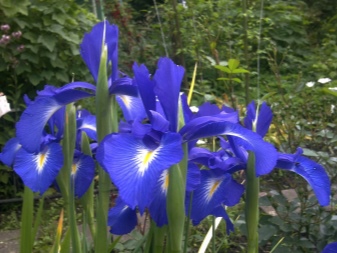
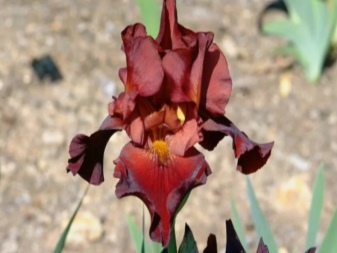
There are several varieties of these flowers that are suitable for planting in open ground. All of them take root well and bloom richly in garden plots or flower beds.
- Bearded and Germanic irises. These two varieties are some of the most popular among gardeners. They are planted in open ground in the middle of summer, so that by next spring they have time to settle down and winter well. They are watered only in dry weather, at the end of summer, old leaves are removed and well covered for the winter. Bearded irises are fed three times a year. A complex of mineral fertilizers is used as a top dressing, but humus or compost are also well suited for this.
- Stunted. Representatives of these varieties are classified as varieties of bearded irises. These plants are only 40 cm tall. They are planted mainly in sunny areas, and they are also fed three times a year.
- Siberian irises. Representatives of these varieties are the most resistant to cold temperatures, they are grown even in the northern regions of the country. Unlike other root varieties, they can be planted in the ground to a depth of 7 cm. It is enough to fertilize twice a year - in the spring, when the snow has almost melted, and during the period when the plants are gaining color.
- Net irises. They belong to the bulbous varieties. They need moderate watering, but during the flowering period, their soil should always be moist. They are planted in open ground in early autumn.
- Dutch. Unlike mesh varieties, they do not need constant watering. It is enough to moisturize them only during a long drought, otherwise the plants will get sick and may die. Plants are planted in the ground at the end of summer. After the flowers have faded, their bulbs must be dug up and stored until next year.
- Swamp. Most often they are planted near water bodies. These varieties need abundant moisture, even flooded areas are well suited for them.Plants tolerate frost well, but they must be protected from the wind, especially during the flowering period. Like other varieties, marsh irises need feeding three times a day, especially before winter.
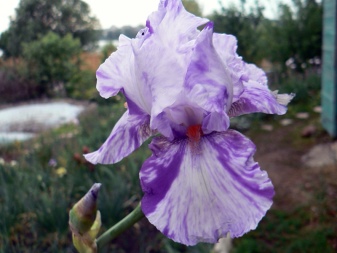

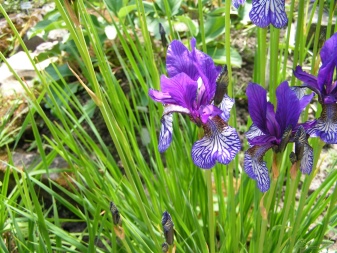
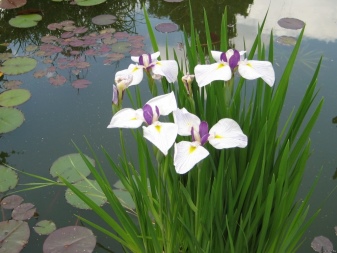
Disembarkation dates
The general rules for planting irises in the ground are quite simple. Plants can be planted in open ground after the flowers have faded, otherwise they will not have time to gain strength for wintering. If early frosts are frequent in your region, then it is better to do this in the spring. The roots of young flowers are unstable to cold, they can freeze before winter. It is advisable to plant irises before lunchtime and on calm days.
The optimal time for planting bulbous varieties is from April to May. It is most likely that irises will bloom the next year after they are planted in open ground.
Rhizome varieties can tolerate frost. As a rule, they begin to be planted in open ground from mid-summer to early autumn. They feel quite comfortable in winter, but the plant must have time to form a bush. The roots of young flowers are not resistant to cold and can freeze before winter.
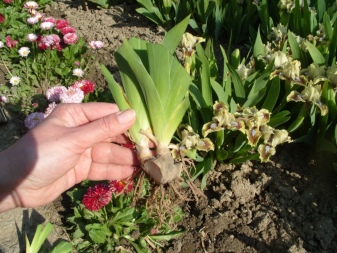
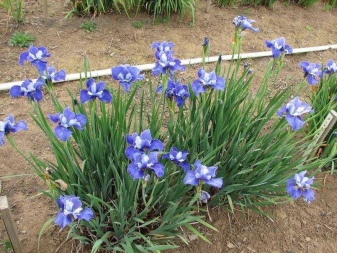
Site selection and soil preparation
Before choosing varieties and planting irises, you must first prepare the soil and the place for planting them. Irises are usually grown in separate flower beds, along fences, or around trees. The main thing is to choose one specific place and not scatter them all over the site. It should be remembered that these are thermophilic plants and a place in the sun is well suited for them.
Irises have their own characteristics, and it is advisable to take them into account before planting plants.
- In one place, irises can grow for more than 10 years, but during this time the soil under them can become scarce and poor. To avoid this, they are transplanted to a new place every 3 years.
- These flowers have a very strongly developed root system, they can grow in breadth, displacing everything around them, or grow tightly on top of each other.
- Old plant roots die off. If you do not correct and do not guide them, then the middle of the bush can become bare.
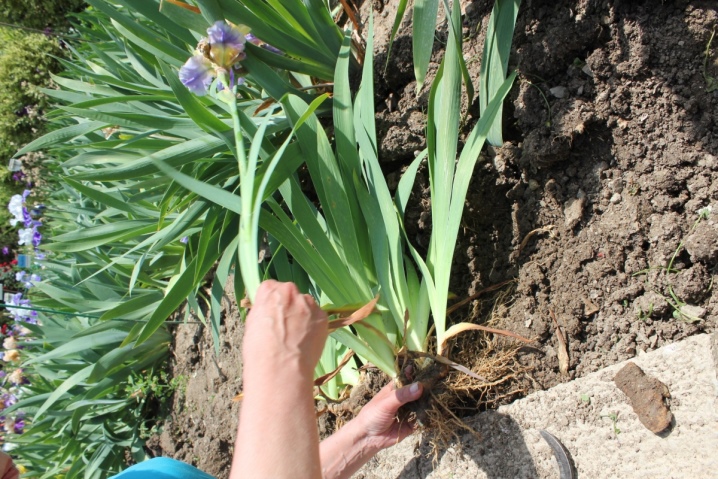
The soil for irises is prepared approximately one month before their planting. The flowerbed is carefully weeded and dug up. Do this to avoid weed germination. The soil will be more suitable for flowers if humus is poured onto the flower bed at the rate of 2 buckets per 1 sq. m. Then you need to evenly scatter over the same area 2-3 glasses of ash and a glass of superphosphate. At the end, add a bucket of sand to the flowerbed, dig everything thoroughly and spill it well with water.
The flower bed itself must be made above ground level. Its height can be 10-15 cm from ground level. At the end, it must be covered with another layer of sand so that the water does not stagnate. After that, the flower bed must be spilled abundantly with water, and after a while the sprouted weeds must be weeded.
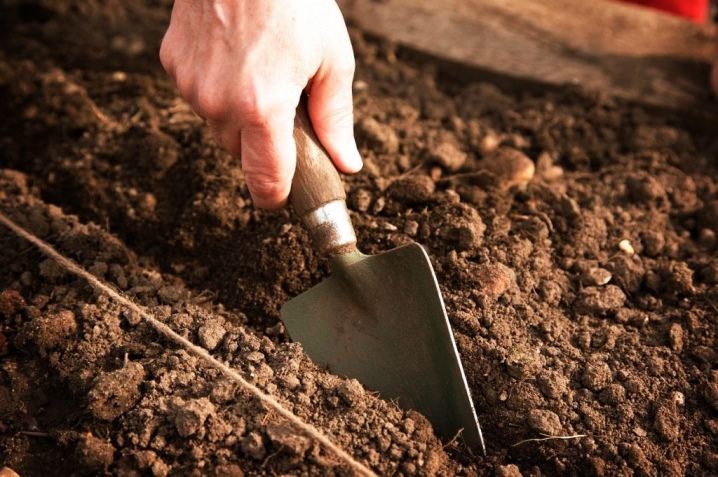
Another option: you can cover the flower bed with a film, water as needed and leave it until the plants are planted in the ground.
How to plant?
Before planting flowers in open ground, you must prepare the holes in advance. The distance between them depends on the variety. High varieties are planted at a distance of 40 cm from each other. For varieties with medium height, the spacing between plants should be 20 cm, and undersized varieties can be planted at a distance of 15 cm from each other.
Bulbous irises can be planted at the beginning of spring at a soil temperature of at least 10 degrees. Otherwise, the bulbs will take a long time to germinate or may even freeze.
On a prepared flower bed, where the soil is already mixed with sand and fertilizers, holes are made 10 cm deep.If other flowers grew in this place before the irises, then the holes need to be watered with a solution of potassium permanganate.
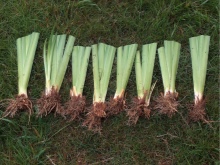
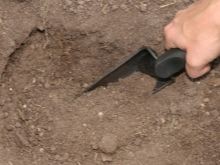

The bulbs are planted 15 to 40 cm apart. Don't plant them too deep. Then, having covered the bulbs with earth, tamp them a little and water them well from a watering can and repeat watering after 3 days. Subsequently, the flowers are irrigated as needed.
If you have small bulbs, the irises will not bloom until next year, even if you do it right.
If you do not follow the rules for planting rhizome varieties, then the flowers may not take root and die. Holes for such varieties are dug by the size of the root, a small mound is formed at the bottom of the hole. The plant is placed with a central root on this hill, and the lateral rhizomes are distributed to the sides. Then the roots must be shed with water and covered with earth. The soil around the seedling is tamped with hands. Then it is finally watered with warm water.
During planting of such varieties, you need to ensure that the central kidney is not underground, it does not need to be buried.
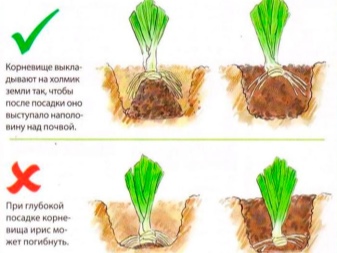
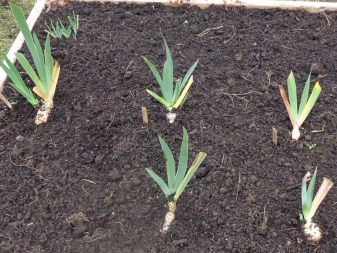
Further care
In order for irises to bloom for a long time, they need to be properly cared for. There are several guidelines that will allow your flowers to gain a foothold, bloom luxuriantly and survive the cold.
One of the main points in caring for planted flowers is their constant feeding. During the season, plants need to be fertilized 3-4 times. The first time the plants are fertilized in the spring, when the shelters are removed after winter. For the first feeding, it is necessary to dilute phosphorus-nitrogen fertilizers in a ratio of 1 to 3. Then, after three weeks, shed the flowers with potassium-nitrogen fertilizers, they are diluted in a ratio of 1 to 1. The flowers are fertilized for the third time after they have completely faded. To do this, dilute phosphorus, nitrogen and potassium in a ratio of 3: 3: 1. The fourth feeding is necessary for the irises to bloom next season. It is carried out in the same way as the third. It is advisable to water the plants in the evening, trying not to wet the flowers themselves.
In addition to fertilizing and watering, it is also necessary to cut off those flower buds that have already faded. It is better to cut the cut closer to the base, being careful not to damage the stem and leaves of the plant.
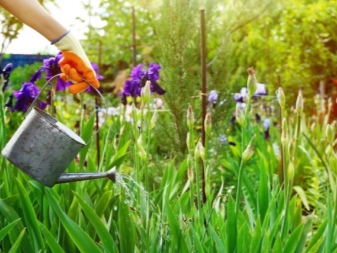
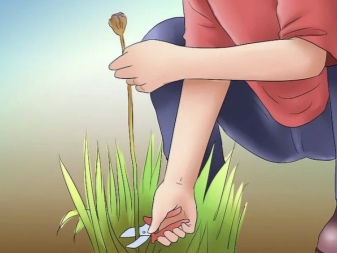
And the last thing: in order to protect young plants from pests and diseases, they are periodically sprinkled with wood ash throughout the year. This is especially important in the spring, after the snow has melted. In the fall, before you cover them for the winter, you must repeat the procedure.
All your efforts will not be in vain, and from May to July, irises will decorate your site with a rich palette of colors.
How to plant irises in spring, see below.







































































































The comment was sent successfully.